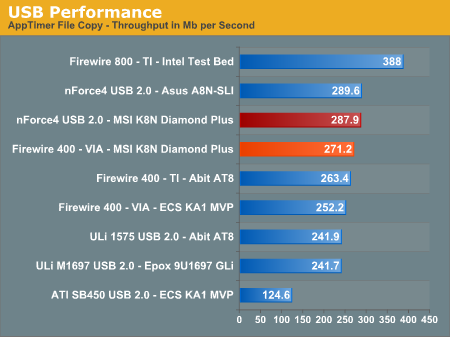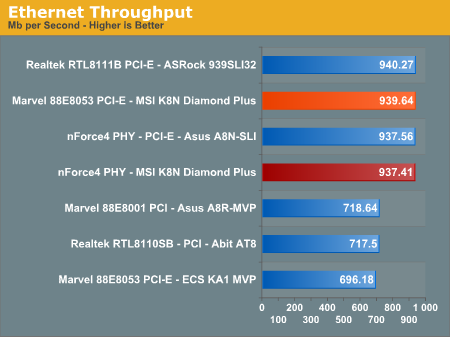Firewire and USB
After looking at many options for Firewire and USB testing, we finally determined that an external USB 2.0, Firewire 400, and Firewire 800 hard disk would be a sensible way to look at USB and Firewire throughput. We utilize a RAM disk as our "server", since memory removes almost all overhead from the serving end. We turn off disk caching on the USB and Firewire side by setting up the drives for "quick disconnect" so our results are consistent.
We use 1GB of fast 2-2-2-5 system memory set up as a 450MB RAM disk and 550MB of system memory. Our standard file is the SPECviewPerf install file, which measures 432,533,504 bytes (412.4961MB). After copying this file to our RAM disk, we measured the time for writing from the RAM disk to our external USB 2.0, Firewire 400, or Firewire 800 drive utilizing our internal Windows based timing program. The copy times in seconds were then converted into Megabits per second (Mb) to provide a convenient means of comparing throughput. Higher Rates therefore mean better performance in this particular test.

The MSI board offers the excellent VIA based IEEE 1394 Firewire option providing better performance than the TI chipset solutions. The USB 2.0 performance is competitive with the other ULi and NVIDIA based controllers in throughput. We did not note any Firewire or USB 2.0 issues with our inventory of peripherals that included steaming data from our USB 2.0 or Firewire 400/800 external storage drive to a USB 2.0 optical drive for backup purposes. Of course, as good as the VIA solution is, it's still a far cry from the performance of Firewire 800. It's surprising that so few companies opt for the faster IEEE 1394B standard, as the price difference can't be very large.
Ethernet Performance
As with recent motherboard reviews, networking performance is measured using the Windows 2000 Driver Development Kit LAN testing utility ntttcp. We set up one machine as the server: an Intel system with an Intel CSA Gigabit LAN connection. Intel CSA has a reputation for providing fast throughput and is a logical choice for our Gigabit LAN server. On the server side, we used the following Command Line:


The NVIDIA nForce4 SLI Southbridge natively supports PCI Gigabit Ethernet operations so the choice of the PCI-E based Marvell 88E8053 10/100/1000Mb/s Ethernet controller as the secondary Gigabit Ethernet controller is an excellent option by MSI.
The performance of the Marvell 88E8053 Gigabit LAN controller is on par with the other boards except for the throughput issue noticed on the ECS implementation of this controller. The Marvell solution provides better throughput than the NVIDIA PHY but at the expense of greater CPU utilization rates. We generally utilized the Marvell controller in our on-line gaming or LAN sessions as it seemed less prone to throughput spikes across our Gigabit network. Although this is a subjective opinion, we are investigating a potential test suite to further look at the extended performance of the network controllers in real world applications.
NVIDIA has tweaked their implementation of ActiveArmor in the latest driver releases by reducing the amount of offloading the ActiveArmor engine provides thereby reducing the amount of hardware based Gigabit Ethernet acceleration. As a result the CPU utilization rates are not as low as before but this was done to avoid data corruption issues that have been dogging NVIDIA since ActiveArmor was introduced. In our testing, we found the driver changes worked as we could not replicate a user based scenario that resulted in data corruption in previous releases. However, we are still testing the driver updates and will provide more information in a future article.
All standard Ethernet tests were performed with standard frames and the NVIDIA ActiveArmor suite disabled unless otherwise noted. Gigabit Ethernet supports Jumbo frames as well and provides a further reduction in CPU overhead.
After looking at many options for Firewire and USB testing, we finally determined that an external USB 2.0, Firewire 400, and Firewire 800 hard disk would be a sensible way to look at USB and Firewire throughput. We utilize a RAM disk as our "server", since memory removes almost all overhead from the serving end. We turn off disk caching on the USB and Firewire side by setting up the drives for "quick disconnect" so our results are consistent.
We use 1GB of fast 2-2-2-5 system memory set up as a 450MB RAM disk and 550MB of system memory. Our standard file is the SPECviewPerf install file, which measures 432,533,504 bytes (412.4961MB). After copying this file to our RAM disk, we measured the time for writing from the RAM disk to our external USB 2.0, Firewire 400, or Firewire 800 drive utilizing our internal Windows based timing program. The copy times in seconds were then converted into Megabits per second (Mb) to provide a convenient means of comparing throughput. Higher Rates therefore mean better performance in this particular test.

The MSI board offers the excellent VIA based IEEE 1394 Firewire option providing better performance than the TI chipset solutions. The USB 2.0 performance is competitive with the other ULi and NVIDIA based controllers in throughput. We did not note any Firewire or USB 2.0 issues with our inventory of peripherals that included steaming data from our USB 2.0 or Firewire 400/800 external storage drive to a USB 2.0 optical drive for backup purposes. Of course, as good as the VIA solution is, it's still a far cry from the performance of Firewire 800. It's surprising that so few companies opt for the faster IEEE 1394B standard, as the price difference can't be very large.
Ethernet Performance
As with recent motherboard reviews, networking performance is measured using the Windows 2000 Driver Development Kit LAN testing utility ntttcp. We set up one machine as the server: an Intel system with an Intel CSA Gigabit LAN connection. Intel CSA has a reputation for providing fast throughput and is a logical choice for our Gigabit LAN server. On the server side, we used the following Command Line:
ntttcpr -m 4,0,‹server IP› -a 4 -l 256000 -n 30000
On the client side (the motherboard under test), we used the following Command Line:ntttcps -m 4,0,‹client IP› -a 4 -l 256000 -n 30000
At the conclusion of the test, we captured the throughput and CPU utilization figures from the client screen.

The NVIDIA nForce4 SLI Southbridge natively supports PCI Gigabit Ethernet operations so the choice of the PCI-E based Marvell 88E8053 10/100/1000Mb/s Ethernet controller as the secondary Gigabit Ethernet controller is an excellent option by MSI.
The performance of the Marvell 88E8053 Gigabit LAN controller is on par with the other boards except for the throughput issue noticed on the ECS implementation of this controller. The Marvell solution provides better throughput than the NVIDIA PHY but at the expense of greater CPU utilization rates. We generally utilized the Marvell controller in our on-line gaming or LAN sessions as it seemed less prone to throughput spikes across our Gigabit network. Although this is a subjective opinion, we are investigating a potential test suite to further look at the extended performance of the network controllers in real world applications.
NVIDIA has tweaked their implementation of ActiveArmor in the latest driver releases by reducing the amount of offloading the ActiveArmor engine provides thereby reducing the amount of hardware based Gigabit Ethernet acceleration. As a result the CPU utilization rates are not as low as before but this was done to avoid data corruption issues that have been dogging NVIDIA since ActiveArmor was introduced. In our testing, we found the driver changes worked as we could not replicate a user based scenario that resulted in data corruption in previous releases. However, we are still testing the driver updates and will provide more information in a future article.
All standard Ethernet tests were performed with standard frames and the NVIDIA ActiveArmor suite disabled unless otherwise noted. Gigabit Ethernet supports Jumbo frames as well and provides a further reduction in CPU overhead.










42 Comments
View All Comments
JarredWalton - Tuesday, April 11, 2006 - link
Just FYI, I've sent Gary a message to check the FEAR and COD2 CF numbers. They seem a bit low to me, but I haven't personally tested a CF system so I can't say for sure. Gary will most likely be on in a couple hours to comment, once he gets out of bed. Which is where I need to go now....Take care,
Jarred Walton
Hardware Editor
AnandTech.com
JarredWalton - Tuesday, April 11, 2006 - link
It looks like the current FEAR and COD2 scores for Crossfire are correct, in that CF doesn't work fully right now. Unlike SLI where profiles can be manually force, CF mostly works or not. Just in case anyone was wondering. :)